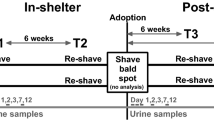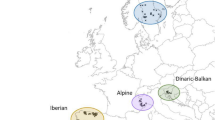Abstract
Breeding wild animals for restocking imply their ability to respond to wild conditions and to overcome the stress of transport and cage rearing. Cortisol was used in animals to measure stress levels. Aims of the study were to ascertain if a difference in hair cortisol concentration (HCC) existed between hares raised according to different breeding technologies (familiar, semi-industrial, industrial breeding) before transportation and after a pre-acclimatization period, and if a short period of adaptation could reduce the stress status. Hair samples were collected from 120 hares from an area of approximately 13.5 sp cm from the left sulcus jugularis by using an electric hair clipper, at day 0 (d0) and after 15 days (d15), and processed by previously established procedures. HCC significantly decreased at d15 compared to d0 in all groups. A significant difference in HCC was detected between female hares of the three groups at d0, between male and female animals belonging to the industrial group at d15, between d0 and d15 in female hares belonging to the familiar and to the industrial group, and between d0 and d15 in male hares belonging to all groups. The different breeding technologies considered resulted exerting different stress levels in hares. Fifteen days of pre-acclimatization in a low-stress environment significantly reduced HCC. Controversial results have been obtained with female subjects from the industrial group, suggesting possible complex relationships between gender and HCC.
Similar content being viewed by others
References
Accorsi PA, Carloni E, Valsecchi P, Viggiani R, Gamberoni M, Tamanini C, Seren E (2008) Cortisol determination in hair and faeces from domestic cats and dogs. Gen Comp Endocrinol 155(2):398–402. doi:10.1016/j.ygcen.2007.07.002
Arias N, Requena M, Palme R (2013) Measuring faecal glucocorticoid metabolites as a non-invasive tool for monitoring adrenocortical activity in South American camelids. Anim Welf 22(1):25–31. doi:10.7120/09627286.22.1.025
Ashley NT, Barboza PS, Macbeth BJ, Janz DM, Cattet MRL, Booth RK, Wasser SK (2011) Glucocorticosteroid concentrations in feces and hair of captive caribou and reindeer following adrenocorticotropic hormone challenge. Gen Comp Endocrinol 172:382–391
Bechshøft TØ, Sonne C, Dietz R, Born EW, Novak MA, Henchey E, Meyer JS (2011) Cortisol levels in hair of East Greenland polar bears. Sci Total Environ 409:831–834. doi:10.1016/j.scitotenv.2010.10.047
Bechshøft TØ, Rigét FF, Sonne C, Letcher RJ, Muir DCG, Novak MA, Henchey E, Meyer JS, Eulaers I, Jaspers VLB, Eens M, Covaci A, Dietz R (2012) Measuring environmental stress in East Greenland polar bears, 1892–1927 and 1988–2009: what does hair cortisol tell us? Environ Int 45:15–21. doi:10.1016/j.envint.2012.04.005
Bennett A, Hayssen V (2010) Measuring cortisol in hair and saliva from dogs: coat color and pigment differences. Domest Anim Endocrinol 39:171–180. doi:10.1016/j.domaniend.2010.04.003
Brearley G, McAlpine C, Bell S, Bradley A (2012) Influence of urban edges on stress in an arboreal mammal: a case study of squirrel gliders in southeast Queensland, Australia. Landsc Ecol 27:1407–1419. doi:10.1007/s10980-012-9790-8
Caslini C, Comin A, Peric T, Prandi A, Pedrotti L, Mattiello S (2016) Use of hair cortisol analysis for comparing population status in wild red deer (Cervus elaphus) living in areas with different characteristics. Eur J Wildl Res. doi:10.1007/s10344-016-1049-2
Comin A, Veronesi MC, Montillo M, Faustini M, Valentini S, Cairoli F, Prandi A (2012) Hair cortisol level as a retrospective marker of hypothalamic–pituitary–adrenal axis activity in horse foals. Vet J 194:131–132. doi:10.1016/j.tvjl.2012.04.006
Davenport MD, Tiefenbacher S, Lutz CK, Novak MA, Meyer JS (2006) Analysis of endogenous cortisol concentrations in the hair of rhesus macaques. Gen Comp Endocrinol 147:255–261. doi:10.1016/j.ygcen.2006.01.005
Dettmer AM, Novak MA, Suomi SJ, Meyer JS (2011) Physiological and behavioral adaptation to relocation stress in differentially reared rhesus monkeys: hair cortisol as a biomarker for anxiety-related responses. Psychoneuroendocrinology 37(2):191–199. doi:10.1016/j.psyneuen.2011.06.003
Dobrakovová M, Kvetnanský R, Oprsalová Z, Jezová D (1993) Specificity of the effect of repeated handling on sympathetic-adrenomedullary and pituitary-adrenocortical activity in rats. Psychoneuroendocrinology 18(3):163–174. doi:10.1016/0306-4530(93)90001-2
Fischer C, Tagand R (2012) Spatial behaviour and survival of translocated wild brown hares. Anim Biodivers Conserv 35(2):189–196
Franci O, Amici A, Margarit R, Merendino N, Piccolella E (1996) Influence of thermal and dietary stress on immune response of rabbits. J Anim Sci 74:1523-1529
González-de-la-Vara MDR, Valdez RA, Lemus-Ramirez V, Vázquez-Chagoyán JC, Villa-Godoy A, Romano MC (2011) Effects of adrenocorticotropic hormone challenge and age on hair cortisol concentrations in dairy cattle. Can J Vet Res 75:216–221
Hamel AF, Meyer JS, Henchey E, Dettmer AM, Suomi SJ, Novak MA (2011) Effects of shampoo and water washing on hair cortisol concentrations. Clin Chim Acta 412(3–4):382–385. doi:10.1016/j.cca.2010.10.019
Ito N, Ito T, Kromminga A, Bettermann A, Takigawa A, Kees F, Straub RH, Paus R (2005) Human hair follicles display a functional equivalent of the hypothalamic-pituitary-adrenal (HPA) axis and synthesize cortisol. FASEB J 19(10):1332–1334
Janicki Z, Konjevic D, Pintur K, Severin K, Slavica A, Masek T (2006) Non-invasive monitoring of cortisol metabolites level in farmed brown hare (Lepus europaeus). Veterinarski Arhiv 76(Suppl):251–257
Keckeis K, Lepschy M, Schöpper H, Moser L, Troxler J, Palme R (2012) Hair cortisol: a parameter of chronic stress? Insights from a radiometabolism study in guinea pigs. Journal of Comparative Physiology B: Biochemical, Systemic, and Environmental Physiology 182(7):985–996
Koren L, Mokady O, Karaskov T, Klein J, Koren G, Gleffen E (2002) A novel method using hair for determining hormonal levels in wildlife. Anim Behav 63:403–406. doi:10.1006/anbe.2001.190
Manenschijn L, Koper JW, Lamberts SWJ, van Rossum EFC (2011) Evaluation of a method to measure long term cortisol levels. Steroids 76:1032–1036. doi:10.1016/j.steroids.2011.04.005
Mastromonaco GF, Gunn K, McCurdy-Adams H, Edwards DB, Schulte-Hostedde AI (2014) Validation and use of hair cortisol as a measure of chronic stress in eastern chipmunks (Tamias striatus). Conservation Physiology 2(1):cou055
Romero LM (2004) Physiological stress in ecology: lessons from biomedical research. Trends Ecol Evol 19(5):249–255. doi:10.1016/j.tree.2004.03.008
Russell E, Koren G, Rieder M, Van Uum SHM (2011) Hair cortisol as a biological marker of chronic stress: current status, future directions and unanswered questions. Psychoneuroendocrinology 37(5):589–601. doi:10.1016/j.psyneuen.2011.09.009
Sauvé B, Koren G, Walsh G, Tokmakejian S, Van Uum SHM (2007) Measurement of cortisol in human hair as a biomarker of systemic exposure. Clinical & Investigative Medicine 30(5):E183–E191
Sheriff MJ, Bosson CO, Krebs CJ, Boonstra R (2009) A non-invasive technique for analyzing fecal cortisol metabolites in snowshoe hares (Lepus americanus). J Comp Physiol B 179:305–313. doi:10.1007/s00360-008-0314-4
Sheriff MJ, Krebs CJ, Boonstra R (2010) Assessing stress in animal populations: do fecal and plasma glucocorticoids tell the same story? Gen Comp Endocrinol 166:614–619. doi:10.1016/j.ygcen.2009.12.017
Sheriff MJ, Krebs CJ, Boonstra R (2011) From process to pattern: how fluctuating predation risk impacts the stress axis of snowshoe hares during the 10 year cycle. Oecologia 66(3):593–605. doi:10.1007/s00442-011-1907-2
Stalder T, Kirschbaum C (2012) Analysis of cortisol in hair—state of the art and future directions. Brain Behav Immun 26:1019–1029
Stalder T, Steudte S, Miller R, Skoluda N, Dettenborn L, Kirschbaum C (2011) Intraindividual stability of hair cortisol concentrations. Psychoneuroendocrinology 37(5):602–610. doi:10.1016/j.psyneuen.2011.08.007
Stalder T, Steudte S, Alexander N, Miller R, Gao W, Dettenborn L, Kirschbaum C (2012) Cortisol in hair, body mass index and stress-related measures. Biol Psychol 90:218–223. doi:10.1016/j.bbi.2012.02.002
Szeto A, Gonzales JA, Spitzer SB, Levine JE, Zaias J, Saab PG, Schneiderman N, McCabe PM (2004) Circulating levels of glucocorticoid hormones in WHHL and NZW rabbits: circadian cycle and response to repeated social encounter. Psychoneuroendocrinology 29(7):861–866. doi:10.1016/S0306-4530(03)00153-7
Terwissen CV, Mastromonaco GF, Murray DL (2013) Influence of adrenocorticotrophin hormone challenge and external factors (age, sex, and body region) on hair cortisol concentration in Canada lynx (Lynx canadensis). Gen Comp Endocrinol 194:162–167
Acknowledgements
The authors thank Amministrazione Provinciale of Napoli, Ambiti Territoriali di Caccia of Napoli and Catanzaro1, and “Scerbo Serena” farm.
Author information
Authors and Affiliations
Corresponding author
Rights and permissions
About this article
Cite this article
Esposito, L., Auletta, L., Ciani, F. et al. Hair cortisol levels in captive brown hare (Lepus europaeus): potential effect of sex, age, and breeding technology. Eur J Wildl Res 63, 62 (2017). https://doi.org/10.1007/s10344-017-1121-6
Received:
Revised:
Accepted:
Published:
DOI: https://doi.org/10.1007/s10344-017-1121-6




